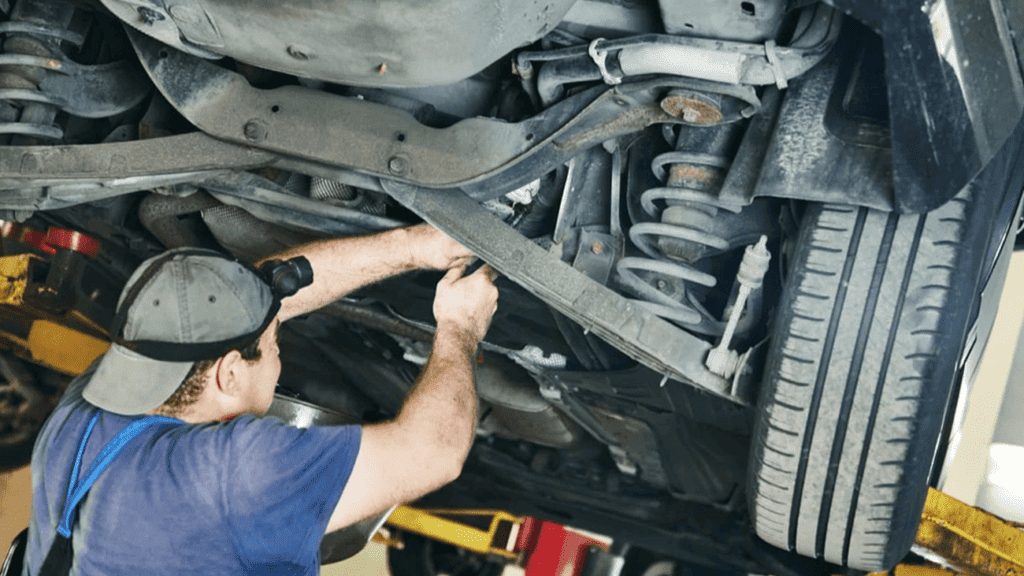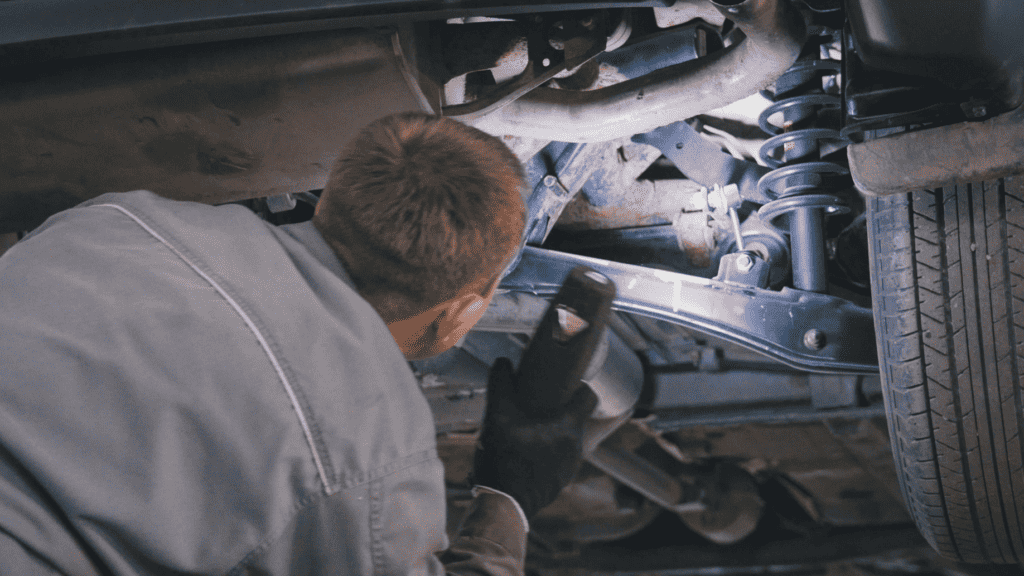The Hidden Savings in Your Suspension System
The next time you drive over a pothole and don’t feel your ancestors turning in their graves, take a moment to thank your car’s shock absorbers and struts. While they are champions in ensuring a smooth ride, they’re also quiet magicians when it comes to saving money. It’s the kind of financial advice you wish your mechanic had the time to share during those quick oil changes.
Why Good Shocks and Struts Matter: Beyond the Comfort
A smooth ride is the most noticeable benefit of well-maintained shocks and struts, but their role in your vehicle goes far beyond merely making your commute more pleasant. For one, they’re crucial for tire longevity. Good shocks ensure even tire wear, optimizing your car’s grip on the road. When your tires have consistent contact with the road, they wear down uniformly, extending their lifespan and improving your vehicle’s overall performance.
Moreover, even tire wear translates to better fuel efficiency. Poorly functioning shocks can lead to uneven tire wear, and thus, less-than-ideal road grip. This forces your engine to work harder to maintain speed and balance, subsequently guzzling more gas. Over time, these “small” inefficiencies can add up, affecting your fuel economy and drilling a hole in your wallet.
In essence, well-maintained shocks and struts are a linchpin in your vehicle’s ecosystem, impacting everything from ride comfort to fuel economy. Their upkeep might seem like a minor detail but neglecting them can result in a ripple effect of escalating costs and deteriorating performance.

The Domino Effect: How Bad Shocks and Struts Impact Other Car Components
Impact on Suspension Springs: When your shocks and struts aren’t doing their job, the springs in your suspension system bear the brunt of the road impacts. Over time, this excessive stress can lead to spring failure, requiring a costly repair or replacement.
Steering System Strain: Poorly maintained shocks and struts can result in unstable steering, creating unnecessary stress on the steering column and linkage. This can make steering your vehicle not just uncomfortable but also dangerous, with parts wearing out prematurely.
Brake Wear and Tear: Worn shocks and struts affect the car’s braking efficiency. If your vehicle nose-dives when braking, this means that an excessive load is being placed on the front brakes, causing them to wear out faster. Your stopping distance also increases, making emergency stops riskier.
Tire Damage: Bad shocks and struts can lead to uneven tire wear, requiring you to replace your tires more frequently than with a well-maintained suspension system. This leads to additional costs and could also affect your vehicle’s fuel efficiency.
Frame and Chassis Stress: Believe it or not, failing shocks and struts can even impact your car’s frame. The additional bouncing and shaking can contribute to the weakening or even cracking of the chassis, the backbone of your vehicle, leading to an extremely costly repair or even the need for a new car.
Increased Fuel Consumption: If your car’s bouncing around more than usual, your engine has to work harder to keep everything stable, leading to increased fuel consumption. This might not sound like much, but it adds up over time, hitting you where it hurts: your wallet.
Potential for Accidents: Ultimately, failing shocks and struts compromise the vehicle’s handling and stability, increasing the risk of an accident. The costs associated with an accident are far greater than any repair or replacement of shocks and struts.
Read the Signs: Early Warnings Before the Financial Storm
• Rougher Ride: One of the first noticeable signs is a decline in ride comfort. If your vehicle feels bouncier or less smooth than usual, this could indicate worn-out shocks or struts. Ignoring this could lead to more severe problems and higher costs down the line.
• Vibrating Steering Wheel: If your steering wheel shakes or vibrates while driving, especially on uneven roads, it’s a sign that your shocks or struts may need attention. This symptom could also indicate other issues like imbalanced tires, but it’s often related to your suspension system.
• Uneven Tire Wear: Inspect your tires regularly for uneven wear patterns. Cupping or scalloping of the tire surface often suggests suspension problems, potentially leading to a need for early tire replacement, an added cost you can avoid.
• Poor Braking: Worn-out shocks and struts can affect your car’s braking system. If you notice a longer stopping distance or nose-diving when braking, consider these strong indicators that your shocks or struts need checking. Poor braking can lead to accidents, the costs of which are much higher than regular maintenance.
• Strange Noises: Hearing creaks, squeals, or clunks when you drive over bumps or take corners? That’s your car’s way of saying something’s wrong. Ignoring these sounds could escalate the problem and result in more expensive repairs.
• Visual Inspection: In some cases, a simple look at the shocks and struts can show you the problem. If you see oil leaking from them, it’s an immediate red flag. Leaks are a strong indication that they need replacement or repair.
The Investment of Routine Check-Ups: Small Costs, Big Returns
It’s often the little things that make a big difference, and in the context of car maintenance, this couldn’t be truer. Think of the routine check-ups for your shocks and struts as your car’s equivalent of a medical check-up. Just as you wouldn’t ignore minor health issues knowing they could escalate into major problems, the same goes for your car’s suspension system.
A basic inspection of your shocks and struts will cost you a fraction of what a major repair or component replacement would. During these checks, a mechanic can identify early signs of wear and tear, allowing you to take preventive action before a minor issue morphs into a major—and far more expensive—repair.
By embracing the principle of preventive maintenance, you’re engaging in a form of financial planning for your car. It’s a small investment now for a significant payoff later, not just in terms of money but also in extending the lifespan of your vehicle.

The Price Comparison: Repairing vs. Replacing
When faced with worn-out shocks and struts, the first instinct for many is to opt for repairs since they usually cost less upfront. However, there’s a financial tipping point to consider. Continual repairs can add up, and if your shocks and struts are significantly deteriorated, you may find yourself in a cycle of ever-increasing maintenance costs.
In such cases, outright replacement can become the more economical option, as new shocks and struts will likely last longer and perform better. But it’s important to weigh this against the overall condition and age of your car. If the vehicle itself is nearing the end of its useful life, investing in high-end components might not offer a good return on investment.
By taking a holistic view of your vehicle’s condition and balancing that against the cost of repairs versus replacement, you can make a financially savvy decision that benefits both your car and your wallet.
Smart Spending: Where Quality Meets Affordability
Cutting corners by buying low-quality replacement parts is a classic penny-wise, pound-foolish move….
• Quality Over Price: Remember, the cheapest option isn’t always the best. Inferior parts can wear out quickly, leading to additional replacements and, thus, more costs over time. Always prioritize quality.
• Research Brands and Reviews: Invest some time in researching various brands and reading customer reviews. This will give you an idea of which brands offer the best value for your money.
• Consult Your Mechanic: Before making a purchase, have a word with your mechanic. They can provide valuable insights into which brands or types are best suited for your specific vehicle, potentially saving you from a costly mistake.
• Compare Prices: Prices for the same quality parts can vary among different suppliers. Always compare prices before buying, but don’t compromise on quality for a slightly lower price.
• Bulk Buying: Some components, like filters or spark plugs, might be cheaper when bought in bulk. However, this tactic is best reserved for parts that have a predictable lifespan and will definitely be used in the future.
• Warranty and Guarantees: Always check for parts that come with a warranty or guarantee. This not only assures quality but can also save you money if the part fails within the warranty period.
Your Roadmap to Financially Savvy Car Maintenance
So there you have it, a comprehensive guide to understanding how maintaining your shock absorbers and struts can save you more money than you might have thought. Remember, the little things add up, and when it comes to car maintenance, what you do today can either cost or save you money tomorrow. If you find yourself in need of a more detailed inspection or professional maintenance service, Uchanics, a mobile mechanic company in Canada, is a convenient and reliable solution for keeping your vehicle in top shape.
Book an appointment today and start your journey to smarter, more financially savvy car maintenance.
